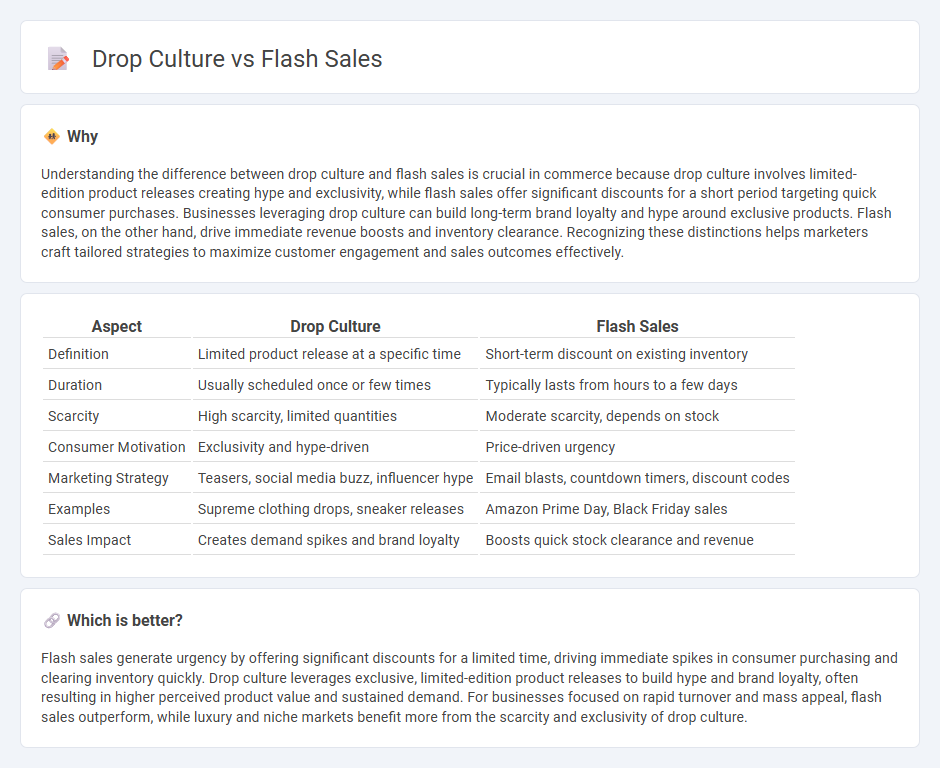
Drop culture revolutionizes commerce by releasing limited product quantities at unpredictable times, creating scarcity and exclusivity that drive consumer urgency and brand loyalty. Flash sales offer time-limited discounts, rapidly boosting sales volume and clearing inventory while attracting price-sensitive shoppers. Explore how combining drop culture with flash sales can maximize market impact and consumer engagement.
Why it is important
Understanding the difference between drop culture and flash sales is crucial in commerce because drop culture involves limited-edition product releases creating hype and exclusivity, while flash sales offer significant discounts for a short period targeting quick consumer purchases. Businesses leveraging drop culture can build long-term brand loyalty and hype around exclusive products. Flash sales, on the other hand, drive immediate revenue boosts and inventory clearance. Recognizing these distinctions helps marketers craft tailored strategies to maximize customer engagement and sales outcomes effectively.
Comparison Table
| Aspect | Drop Culture | Flash Sales |
|---|---|---|
| Definition | Limited product release at a specific time | Short-term discount on existing inventory |
| Duration | Usually scheduled once or few times | Typically lasts from hours to a few days |
| Scarcity | High scarcity, limited quantities | Moderate scarcity, depends on stock |
| Consumer Motivation | Exclusivity and hype-driven | Price-driven urgency |
| Marketing Strategy | Teasers, social media buzz, influencer hype | Email blasts, countdown timers, discount codes |
| Examples | Supreme clothing drops, sneaker releases | Amazon Prime Day, Black Friday sales |
| Sales Impact | Creates demand spikes and brand loyalty | Boosts quick stock clearance and revenue |
Which is better?
Flash sales generate urgency by offering significant discounts for a limited time, driving immediate spikes in consumer purchasing and clearing inventory quickly. Drop culture leverages exclusive, limited-edition product releases to build hype and brand loyalty, often resulting in higher perceived product value and sustained demand. For businesses focused on rapid turnover and mass appeal, flash sales outperform, while luxury and niche markets benefit more from the scarcity and exclusivity of drop culture.
Connection
Drop culture and flash sales both capitalize on limited-time availability to drive consumer urgency and exclusivity in commerce. Drop culture releases limited-edition products in small quantities at specific times, creating hype and scarcity that boost demand. Flash sales offer substantial discounts for a brief period, prompting rapid purchases and increasing conversion rates through time-sensitive offers.
Key Terms
Scarcity
Flash sales create urgency by offering limited-time deals, driving immediate purchases through scarcity marketing. Drop culture leverages exclusive product releases with limited quantities, fostering community engagement and high demand anticipation. Discover how these scarcity strategies transform consumer behavior and boost brand loyalty.
Urgency
Flash sales create urgency through limited-time offers that drive immediate purchases by capitalizing on scarcity and time constraints. Drop culture intensifies urgency by releasing exclusive, often hyped products in small quantities, fostering a sense of exclusivity and anticipation. Discover how these strategies transform consumer behavior and boost sales performance.
Exclusivity
Flash sales create urgency by offering limited-time access to exclusive products, driving rapid consumer engagement and impulse purchases. Drop culture thrives on scarcity and anticipation, releasing highly coveted items in limited quantities to maintain brand prestige and desirability. Explore how these strategies shape modern marketing and consumer behavior.
Source and External Links
What Is A Flash Sale? How to Run One and Examples (2025) - A flash sale is a limited-time discount promotion that creates urgency and taps into shoppers' fear of missing out to boost sales, but it requires preparation to avoid margin erosion and customer dissatisfaction while potentially increasing customer loyalty and lifetime value.
What are flash sales? - Flash sales are short-term, quantity-limited discounts that encourage impulse buying, often used by ecommerce stores to quickly clear excess or seasonal inventory and increase sales velocity.
Flash Sales Guide: Expert Tips, Ideas & Examples - Flash sales offer deep discounts typically lasting a few hours to a few days and, while effective, they carry risks such as lower profitability, order processing strain, and possible brand fatigue if overused, emphasizing the importance of strategic timing and preparation.
 dowidth.com
dowidth.com